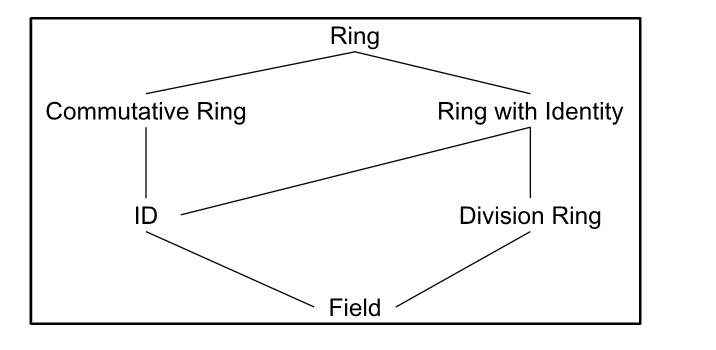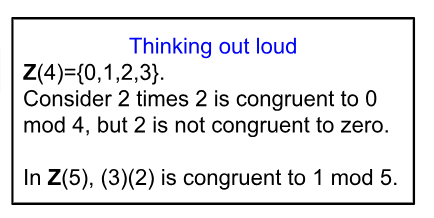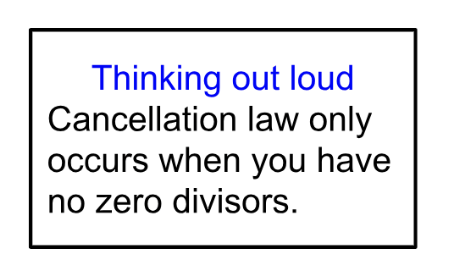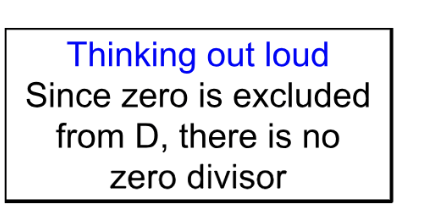5.1: Introduction to Rings
( \newcommand{\kernel}{\mathrm{null}\,}\)
Recall a group is a set with a binary operation; rings are algebraic structures similar to groups but with two operations instead of one.
A non-empty set R with two binary operations, addition and multiplication - denoted by + and ⋅, is called a ring if:
-
(R,+) is an abelian group .
-
(R,⋅) is a semigroup: a⋅b∈R,∀a,b∈R and a⋅(b⋅c)=(a⋅b)⋅c,∀a,b,c∈R. R in this context is a ring.
-
Multiplication distributes over addition: a⋅(b+c)=a⋅b+a⋅c and (b+c)⋅a=b⋅a+c⋅a, ∀a,b,c∈R. (Distributive property).
We call the additive identity 0 is zero. The additive inverse is called the negative element.
{0} is a ring called zero ring.
In this chapter, we will denote a⋅b as ab (skipping the ⋅ notation).
A ring (R,+,⋅) is called a commutative ring if ab=ba,∀a,b∈R.
A ring (R,+,⋅) has a unity(identity) e∈R if ae=ea=a,∀a∈R. Note unity is always a unique, single element.
An element a∈R is called a unit if there exists an a−1∈R s.t. aa−1=e.
- (Z,+,⋅) is a commutative ring with unity 1.
-
(Zn,⨁,⨀) (modulo n addition and multiplication) is a commutative ring with unity 1 and units of U(n) since they must be all the elements relatively prime to n.
-
(Z[x],+,⋅) where Z[x] is the set of all integer polynomials in variable x, is a commutative ring with unity of 1 and units of ±1.
-
(M22(Z),+,⋅) is a ring, from the set of all 2×2 matrices with integer entries, that has unity I. It is a non-commutative ring. The units are the set of all 2×2 matrices with a non zero determinant (GL2(Z)).
-
(Q,+,⋅) is a field.It is a commutative ring with unity 1 and each a∈Q∖{0} is a unit.
-
(R,+,⋅) is a field. It is a commutative ring, and inverses exist for all elements except 0.
-
(C,+,⋅) is also a field, and inverses exist for all elements except 0.
-
A polynomial ring R[x] over a ring R is defined as {(p(x)=a0+a1x+⋯+anxn∣n∈Z,n≥0,ai∈R,∀i=1,⋯,n}. Where ai is the coefficient of xi, also called the coefficients of the polynomial, and the non-negative integer n is called the degree of the polynomial.
The coefficients ai can be elements from any ring, such as integers, rational numbers, real numbers, complex numbers, or even other polynomials. The addition and multiplication of R[x] are the addition and multiplication R.
Integral Domain (ID)
Recall: (R,+,⋅) is a non-empty set with closed binary operations.
(R,+) is abelian.
(R,⋅) is a semigroup. Recall that this is a set with an associative operation and no identity.
(R,+,⋅) is distributive, has unity (aka identity) of 1 and unit of aa−1=e
If ab=ba, the ring is commutative on ⋅.
A commutative ring with unity (aka identity), R, is called an integral domain if for every a,b∈R, ab=0 implies a=0 or b=0.
Examples of non-integral domains:
1. In the ring Z6 (integers modulo 6), 2 \cdot 3 = 6 \equiv 0 \pmod{6} , but neither 2 nor 3 is zero in \mathbb{Z}_6 .
2. In the ring (M_{22}(\mathbb{Z}), +, \cdot);
\begin{bmatrix} 1 & 0 \\0 & 0 \end{bmatrix} \begin{bmatrix} 0 & 0 \\0 & 1 \end{bmatrix}=\begin{bmatrix} 0 & 0 \\0 & 0 \end{bmatrix}, but neither \begin{bmatrix} 1 & 0 \\0 & 0 \end{bmatrix} nor \begin{bmatrix} 0 & 0 \\0 & 1 \end{bmatrix} equal zero.
A division ring is a ring, (R), with an identity in which for every non-zero a \in R, there exists b \in R s.t. ab=1=ba.
Examples of division rings:
(\mathbb{Q},+,\cdot), (\mathbb{R},+,\cdot), and (\mathbb{C},+,\cdot), \mathbb{Z}_p , where p is prime.
A field is a commutative division ring.
Examples of fields are: (\mathbb{Q},+,\cdot), (\mathbb{R},+,\cdot), \mathbb{Z}_p , where p is prime,
and (\mathbb{C},+,\cdot), with the later being algebraically closed.

A non-zero element of a \in R is called a zero divisor if there exists ab \in R s.t. ab=0.
(\mathbb{Z},+,\cdot).
Since there are no zero divisors, it is an integral domain. It is a commutative ring. Not every non-zero element is a unit. Thus, it is not a field.
(\mathbb{Z}_n,\oplus,\odot).
There are two cases.
This is a finite field if n is prime.
If n is not prime, it is not an integral domain since it will have a zero divisor.
The set of all real-valued differentiable functions on [a,b] is a commutative ring with a unit. This area of study is called differential algebra.
M_{22}(\mathbb{R},+,\cdot)).
The addition is abelian. It is not commutative. It has an identity. It's not an integral domain.
This area of study is called matrix algebra.
Let 
1=\begin{bmatrix} 1 & 0 \\0 & 1 \end{bmatrix}, I= \begin{bmatrix} 0 & 1 \\-1 & 0 \end{bmatrix}, J= \begin{bmatrix} 0 & i \\i & 0 \end{bmatrix}, K= \begin{bmatrix} i & 0 \\0 & -i \end{bmatrix} .
In other words, I^2=J^2=K^2=IJK=-1.
Define
\mathbb{H}= \{ a+bI+cJ+dK \mid a,b,c,d \in \mathbb{R} \}. Then \mathbb{H} is Ring of Quaternions which is a division ring but not a field.
* discovered by Hamilton in 1843.
Let
\mathbb{H}= \left \{ \begin{bmatrix} a & b \\- \bar{b} & \bar{a} \end{bmatrix} \mid a, b \in \mathbb{C} \right\}.
Then \mathbb{H} is a division ring with matrix addition and multiplication, but not an integral domain.
Properties of Rings
 Let D be a commutative ring with identity. Then D is an integral domain if and only if ab=bc implies b=c\; \forall a,b,c \in D.
Let D be a commutative ring with identity. Then D is an integral domain if and only if ab=bc implies b=c\; \forall a,b,c \in D.
Let (R,+, \cdot) be a ring and a,b \in R.
-
a0=0=0a.
-
a(-b)=(-a)b=-ab.
-
(-a)(-b)=(ab).
- Answer
-
1. Let a \in R. Then 0 a=(0+0) a=0a+0a. \implies 0a+0=0a+0a. By cancellation law of + , we get 0a=0. Similarly, we can show that a 0=0.
2. Let a, b \in R. Then ab+(-a)b=(a+(-a))b=0 b=0. \implies (-a)b=-(ab). Similarly, ab+a(-b)=a(b+(-b))=a 0=0. \implies a(-b)=-(ab).
Subring:
Let (R,+,\cdot) be a ring.
Let S(\ne 0) \subseteq R.
Then S is a subring of R if (S,+,\cdot) is a ring with the same operations.
Subring Test
Let (R,+,\cdot) be a ring.
S \subseteq R is a subring if and only if the following conditions are satisfied:
-
S \ne \{\}. At least 0\in S.
-
a-b\in S.
-
ab \in S, \; \forall a,b \in S.
Let (R,+,\cdot) be a ring then \{0\} and R are subrings of R and are called the trivial subrings of R.
Let (\mathbb{Q},+, \cdot) is a subring of (\mathbb{R},+, \cdot) and (\mathbb{R},+,\cdot) is a subring of (\mathbb{C},+,\cdot).
(\mathbb{Z}_6,\oplus, \odot) is a ring.
1. Let S=\{0, 3 \} .
Clearly, S is non-empty.
Since 0\oplus 3, 0 \oplus0, and 3 \oplus3, a-b \in S.
Since 0\odot3, 0 \odot 0, and 3 \odot 3, then ab \in S .
Thus S is a subring of (\mathbb{Z}_6,\oplus, \odot).
2.
Let T =\{0, 2, 4 \} .
Clearly, T is non-empty.
Since 0 \oplus 0, 0 \oplus 2, 0 \oplus 4, 2 \oplus 2,2 \oplus 4 and 4 \oplus 4\in T then a-b \in T
Since 0 \odot 0, 0 \odot 2, 0 \odot 4, 2 \odot 2, 2 \odot 4, and 4 \odot 4 \in T, then ab \in T.
Thus T is a subring of (\mathbb{Z}_6,\oplus, \odot).
Define \mathbb{Z}[i]=\{ m+ni|m.n \in \mathbb{Z}\}, where i^2=-1.
This is a ring called Gaussian integers. The units of this ring are \pm1 and \pm i. Hence The ring of Gaussian integers is not a field.This is a subring of (\mathbb{C},+,\cdot ).
Every finite integral domain is a field.
- Answer
-
Let D be a finite integral domain.
Let D^{*} = D \backslash \{0\}.
We shall show that every element in D^* is a unit (i.e., aa^{-1}=e,\; \forall a \in D^*).
Let a\in D^*.
Define \lambda_a : D^* \rightarrow D^* by \lambda_a(x)=ax, \; x\in D^*.
We shall show that \lambda_a is injective.
Let x_1, x_2 \in D^* s.t. \lambda_a(x_1)=\lambda_a(x_2).
Consider ax_1=ax_2.
Thus ax_1-ax_2=0.
So a(x_1-x_2)=0.
Since D is an integral domain, either a=0 or (x_1-x_2)=0\).\)
Since D^* excludes zero, a \ne 0.

Thus x_1-x_2=0.
Hence x_1=x_2 and \lambda_a is injective.
Since D and D^* are finite, \lambda_a is surjective.
Since 1 \in D^*, \; \exists x \in D^* s.t. \lambda_a(x)=1.
Thus, a is a unit, and therefore, it is a field
Characteristic of a ring R
Let r \in R , then r+r=2r, r+r+r=3r, \cdots, r+ \cdots+ r =nr.
The characteristic of a ring R is the least positive integer n such that nr=0, \forall r \in R. If no such n exists, we say that the characteristic of ring R is 0.
-
( \mathbb{Z}, + \cdot), ( \mathbb{Q}, + \cdot), ( \mathbb{R}, + \cdot), ( \mathbb{C}, + \cdot) are rings of characteristic 0.
-
(\mathbb{Z}_6,\oplus, \odot) is a ring of characteristic 6.
-
Let R be ring with identity 1. If n is the least positive integer such that n1=0, then the characteristic of ring R is 0.
-
The characteristic of an integral domain is either prime or 0.


